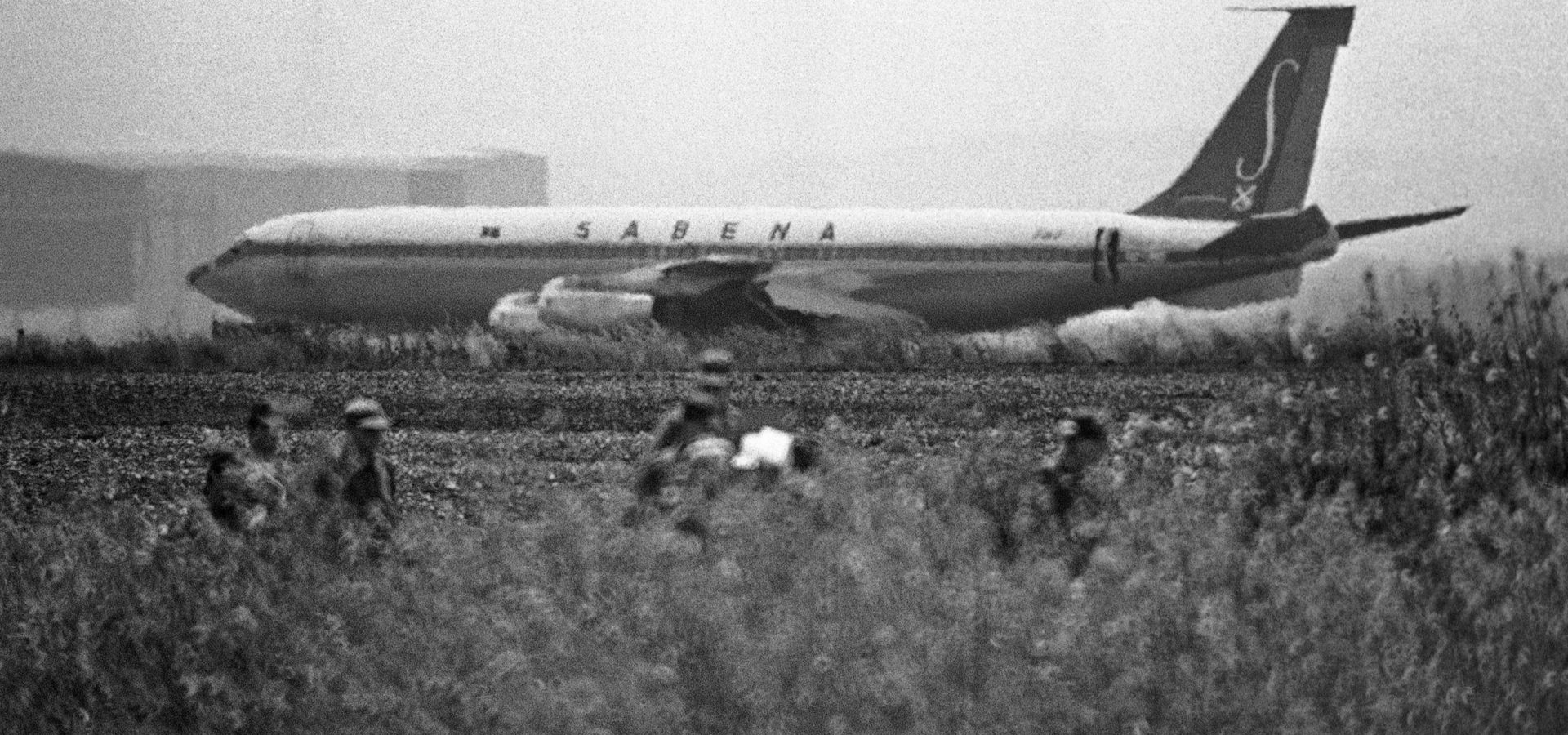By Miko Peled

JERUSALEM — Suheila took out the gold, heart-shaped medallion she wears and showed me the images engraved on it — one side has an image of her son, Adnan, as a young man and the other side has an image of her brother, Ali. Ali was killed in 1972 during a hijacking operation; he was 34 years old. Following his death, Suheila worked tirelessly for two years before the Israeli authorities agreed to hand over his body so that she could give him a proper burial. Last night, in a neighborhood in East Jerusalem, she told me the entire story.
It was May 8, 1972, when four Palestinian fighters from the Black September resistance organization hijacked Sabena Belgian airline Flight 571 on its way to Tel Aviv. Suhaila’s brother, Ali Taha, was the commander of the team. The purpose of the operation was to demand the release of several hundred Palestinian prisoners held in Israeli jails. Ali had participated in a similar operation several years earlier. In July 1968, an Israeli airliner was hijacked and made to land in Algeria. The operation succeeded, Israel released two dozen prisoners, and the passengers and crew of the plane were safely released.
This time the Sabena airliner was on the tarmac less than 24 hours when Israeli commandos dressed in white overalls and pretending to be mechanics stormed the plane. They killed Ali and his deputy, Abdel Aziz Atrash, and arrested the two female members of the team, Theresa Halasa, and Rima Tanous. The two women were later released in a prisoner exchange between Israel and the PLO. The Israeli commandos firing inside the plane also caused the death of two of the passengers and slightly wounded two of the commando officers, one of whom was Benjamin Netanyahu.
Ali Taha left behind three young daughters and a young wife, Fathiya, who was expecting their fourth child. The eldest daughter, Raeda, wrote a play about her life growing up as a child of a Palestinian martyr, a Shahid called “Looking for Ali.” According to a piece in The New York Times, “Ms. Taha’s show has drawn large crowds and critical acclaim.” Before she introduced me to her aunt, Suheila, Ms. Taha was kind enough to send me the script to read, and it is truly remarkable.
Having seen the Palestinian resistance in all of its shades, Raeda Taha is brutally honest, and she remains loyal to the last will and testament that her father left. In a segment from his will that Raeda included in the play, Ali Taha writes:
There is a charge or trust we ask of you, one that every honest revolutionary aspires to, a trust to be fulfilled as a national duty irrespective of sacrifice: you must keep out of our ranks all who do not belong to them, all mercenaries and skeptics, all who join the revolution for private gain. Their number is doubtless very large and they are the greatest danger to us because they have no sense of decency or honor. Their only aim is to gratify their personal pleasures.”
A Necropolis
After Ali and Abdel Aziz were killed, a funeral was held for them in Beirut. “As I walked in the procession, I heard people comment that the coffins were empty,” Raeda told me. The seven-year-old Raeda heard this and she was confused. If the coffins were empty then where is her father’s body?
The first time I learned that Israeli authorities keep the bodies of Palestinians killed in action, I was in Ramallah with my friend Jamal, himself a former prisoner. We were driving through the city when we noticed a procession of cars honking and covered with Palestinian flags. Jamal stopped the car and said it looked like a procession for a prisoner that was released, only he was not aware of any releases taking place that day. He went to inquire and when he came back he told me something that I can still not get over, to this day: The Israeli authorities had just released the body of a Palestinian who was killed 20 years earlier. They held the body for 20 years and were only then releasing it to the family for burial.
Another shocking revelation was when I saw one of the sites where Israel keeps the bodies of Palestinians. During a visit to Kibbutz Zikim, which is a kibbutz on the southern Mediterranean coast just a few miles north of Gaza, I walked by the local cemetery. Not far from the cemetery but not inside it, I could see what looked like unmarked graves each with a number written on a piece of wood. When I asked what it was, I was told by a resident of the kibbutz that the army leased the land just by the cemetery to bury bodies of slain Palestinians. I am told that in some cases the bodies are kept refrigerated at various other locations throughout the country.
Give me my brother
Suheila could not let the body of her brother remain in a cold, dark box. She was determined to bring him home and give him a proper burial. She had written to everyone from the mayor of Hebron, where Ali Taha was born, to the Israeli prime minister, who at the time was Golda Meir. When letters did not help, she visited their offices. “I was passed around like a ball in a soccer match,” she told me.
Each person she approached passed her to another. The minister for religious affairs, the minister of defense, the local municipality, over and over again. “I have a file of documents this thick,” she said, demonstrating with her hands just how thick it is. “It was all for nothing until I went to see attorney Felicia Langer; she was wonderful, like a sister to me”
Langer was an attorney, a holocaust survivor, who dedicated her life to representing and defending Palestinians in the Israeli legal system, which was and still is dedicated to denying their legal rights. In an obituary to Ms. Langer, Gideon Levi wrote in Haaretz newspaper:
What did this brave and courageous woman fight against? Against torture by the Shin Bet security service at a time when we didn’t believe that such torture existed, yet it was at the peak of its cruelty. She fought against the expulsion of political activists, against false arrests, against home demolitions. Above all, she fought for the enforcement of international law from which Israel decided to except itself on unbelievable grounds. That’s what she fought and that is why she was considered a public enemy.”
Each day for over two years Suheila walked up the steep hill from her home in Silwan — also known as Wadi Hilwe — which is a steep valley just outside the Old City of Jerusalem. She visited every newspaper office and every official until one day she finally got a break. She heard on the radio that U.S. Secretary of State Henry Kissinger was in Jerusalem. “I asked the people at one of the newspapers to write a nice letter for me in English.” She then went to the King David Hotel, where all foreign dignitaries stay when they visit the country.
“When I arrived I said, ‘I want to see Kissinger,’” she told me, but she was told that “he does not meet with Arab women.” “Why not?” she asked. Eventually, she spotted Dr. Kissinger, walked up to him, and handed him a letter. “The next day early in the morning, my older brother came knocking at my door, asking where I’d been and what I had done. I told him I gave a letter to Kissinger.” Her brother had a notice from the U.S. consulate that she would be receiving the body of her brother, Ali Taha, and that she must go to the Israeli military headquarters in Beit-El to finalize the arrangements.
On August 5, 1974, after more than two years, Suheila was finally able to bring her brother home. “I demanded to open the coffin and see him. Then I covered his body with the flag of Palestine. Now his daughters have a place where they can visit their father.”
Filed under: Israel, Palestine | Tagged: Ali Taha, Black SEP, Palestinian Resistance, Sabena Flight 571 |
Related posts:
Views: 0
 RSS Feed
RSS Feed

















 August 2nd, 2021
August 2nd, 2021  Awake Goy
Awake Goy 




 Posted in
Posted in  Tags:
Tags: 
















